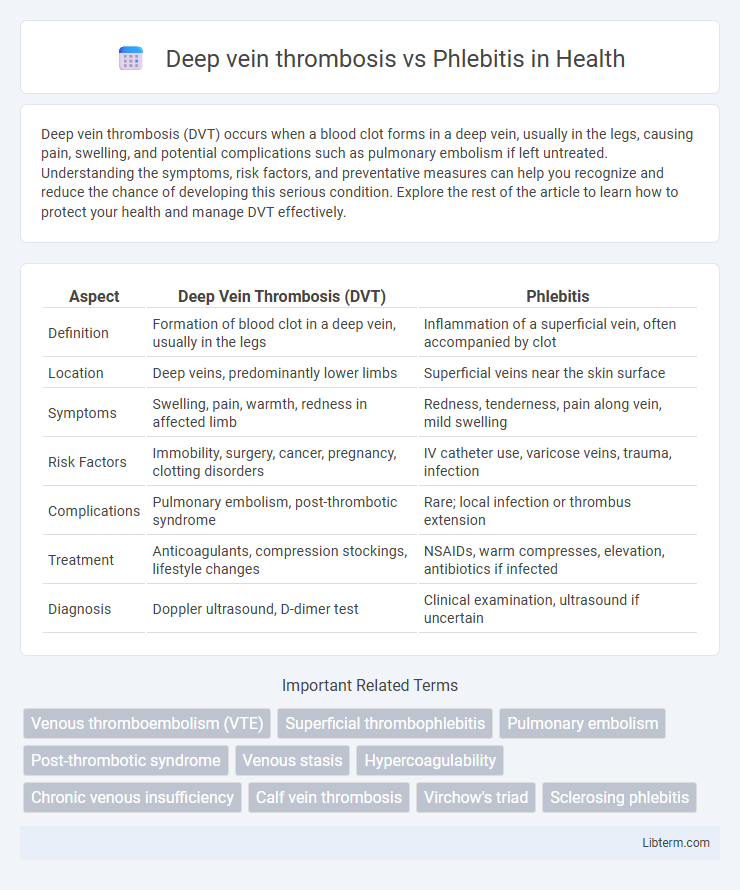Deep vein thrombosis (DVT) occurs when a blood clot forms in a deep vein, usually in the legs, causing pain, swelling, and potential complications such as pulmonary embolism if left untreated. Understanding the symptoms, risk factors, and preventative measures can help you recognize and reduce the chance of developing this serious condition. Explore the rest of the article to learn how to protect your health and manage DVT effectively.
Table of Comparison
| Aspect | Deep Vein Thrombosis (DVT) | Phlebitis |
|---|---|---|
| Definition | Formation of blood clot in a deep vein, usually in the legs | Inflammation of a superficial vein, often accompanied by clot |
| Location | Deep veins, predominantly lower limbs | Superficial veins near the skin surface |
| Symptoms | Swelling, pain, warmth, redness in affected limb | Redness, tenderness, pain along vein, mild swelling |
| Risk Factors | Immobility, surgery, cancer, pregnancy, clotting disorders | IV catheter use, varicose veins, trauma, infection |
| Complications | Pulmonary embolism, post-thrombotic syndrome | Rare; local infection or thrombus extension |
| Treatment | Anticoagulants, compression stockings, lifestyle changes | NSAIDs, warm compresses, elevation, antibiotics if infected |
| Diagnosis | Doppler ultrasound, D-dimer test | Clinical examination, ultrasound if uncertain |
Overview of Deep Vein Thrombosis and Phlebitis
Deep vein thrombosis (DVT) is a condition characterized by the formation of a blood clot within a deep vein, commonly in the legs, which can lead to serious complications like pulmonary embolism. Phlebitis involves inflammation of a vein, often superficial, and may or may not be associated with clot formation, presenting as redness, swelling, and pain along the affected vein. Understanding the differences in pathology, risk factors, and clinical presentation is crucial for accurate diagnosis and effective treatment.
Definition and Basic Differences
Deep vein thrombosis (DVT) is a medical condition characterized by the formation of a blood clot in a deep vein, usually in the legs, posing risks such as pulmonary embolism. Phlebitis refers to inflammation of a vein, often superficial, accompanied by pain and swelling, but typically without clot formation. The primary difference lies in DVT involving clot development in deep veins, whereas phlebitis commonly affects superficial veins with inflammation as the core issue.
Causes and Risk Factors
Deep vein thrombosis (DVT) primarily results from blood clot formation in deep veins due to prolonged immobility, surgery, cancer, or genetic clotting disorders. Phlebitis, characterized by vein inflammation, often arises from injury, infection, intravenous catheter use, or varicose veins. Risk factors for DVT include obesity, smoking, pregnancy, and hormone therapy, while phlebitis risk increases with trauma to superficial veins and prolonged IV therapy.
Common Symptoms and Warning Signs
Deep vein thrombosis (DVT) commonly presents with swelling, pain, and warmth in one leg, often accompanied by redness and tenderness along the affected vein. Phlebitis typically causes localized redness, swelling, tenderness, and a palpable cord-like vein due to inflammation. Both conditions require prompt medical evaluation to prevent complications such as pulmonary embolism in DVT or infection in phlebitis.
Diagnostic Approaches
Deep vein thrombosis (DVT) diagnosis primarily relies on duplex ultrasonography, which combines real-time imaging with Doppler flow studies to detect thrombus presence and venous obstruction. D-dimer blood tests are often used as an initial screening tool for DVT due to their high sensitivity but low specificity, necessitating imaging confirmation. Phlebitis diagnosis involves clinical evaluation of symptoms like localized pain and erythema, with ultrasound used selectively to assess superficial vein inflammation and rule out deep vein involvement.
Complications and Health Risks
Deep vein thrombosis (DVT) presents significant health risks, including pulmonary embolism, post-thrombotic syndrome, and chronic venous insufficiency, which can lead to long-term disability. Phlebitis, primarily involving inflammation of superficial veins, may cause localized pain and swelling but rarely results in life-threatening complications unless it progresses to thrombophlebitis or deeper vein involvement. Recognizing the potential for DVT to cause severe complications emphasizes the importance of early diagnosis and treatment to prevent critical outcomes such as embolism and venous obstruction.
Treatment Strategies
Treatment strategies for deep vein thrombosis (DVT) primarily involve anticoagulant medications such as heparin and warfarin to prevent clot growth and pulmonary embolism. In contrast, phlebitis treatment focuses on anti-inflammatory measures, including nonsteroidal anti-inflammatory drugs (NSAIDs) and warm compresses to reduce inflammation and pain. Both conditions may require compression stockings to improve venous return and reduce swelling.
Prevention Methods
Deep vein thrombosis (DVT) prevention centers on regular physical activity, compression stockings, and anticoagulant medications to reduce blood clot formation in deep veins. Phlebitis prevention involves avoiding vein trauma, maintaining proper hydration, and using warm compresses to minimize inflammation in superficial veins. Both conditions benefit from lifestyle changes such as quitting smoking and managing chronic diseases like diabetes and hypertension.
Prognosis and Long-term Considerations
Deep vein thrombosis (DVT) carries a significant risk of pulmonary embolism and post-thrombotic syndrome, which can cause chronic leg pain and swelling, impacting long-term mobility. Phlebitis, typically inflammation of superficial veins, generally has a more favorable prognosis with lower risk of serious complications but can lead to superficial thrombophlebitis requiring monitoring to prevent extension into deep veins. Long-term management of DVT often involves anticoagulation therapy and regular follow-up to reduce recurrence, while phlebitis usually resolves with anti-inflammatory treatments and compression therapy.
When to Seek Medical Attention
Seek immediate medical attention for deep vein thrombosis (DVT) if you experience symptoms such as sudden leg swelling, pain, warmth, or redness, as untreated DVT can lead to life-threatening pulmonary embolism. Phlebitis requires prompt evaluation when redness, tenderness, and swelling occur along a superficial vein, especially if accompanied by fever, to prevent complications like infection or thrombosis progression. Medical intervention is critical in both conditions to ensure accurate diagnosis and timely treatment.
Deep vein thrombosis Infographic

 libterm.com
libterm.com